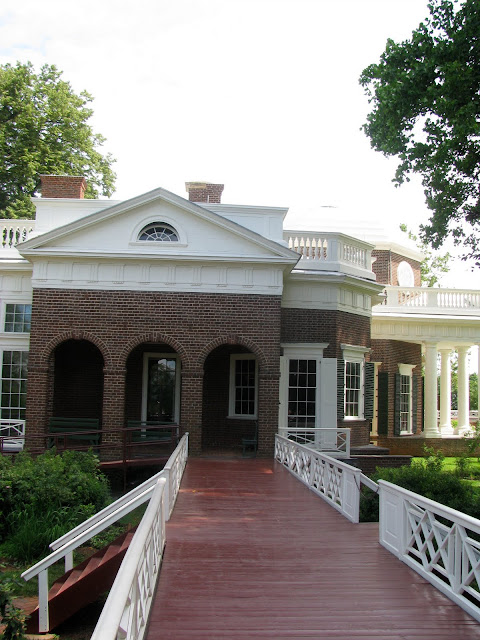On our way from Reston, Virginia to Durham, North Carolina, we stopped at Thomas Jefferson's Monticello (which means "little mountain" in Italian). He inherited 3000 acres from his father, who was a land surveyor in Viriginia. He added another 2000 acres over time.
Many of the windows at Monticello are triple hung, meaning, you can slide up the bottom 2/3rds of the window and walk through it.
Jefferson was a self-taught architect. He admired Palladio, an ancient Roman architect.
Between stints as U.S. Ambassador to France, Secretary of State, Vice President and two terms as President of the United States, Jefferson, built, remodeled, and expanded Monticello.
Sorry, no photos of the interior--not allowed.
An intentional chink in the bricks to insert scaffolding to paint the eaves, put on a new roof, etc.
Horse stables built into the lower level of the house.
Palladian window in a long corridor under the house leading from the kitchen to the stables.
The kitchen was also on the lower floor, with a "dumb waiter" or elevator that delivered the food up to the dining room.
Fig tree on the property.
Row after row of vegetables--everything from asparagus and artichokes to
zucchini.
Fruit trees and and grape arbors.
Artichokes in the kitchen garden.
Jefferson is buried on the property at Monticello. The cemetary is still owned by the Jefferson family and descendants of Jefferson are still buried here.
Thomas Jefferson was 33 when he wrote the Declaration of Independence. When he died he was $107,000 in debt. At times he had upwards of 200 people living at Monticello. He had 140 slaves. His daughter and her 11 children lived with him as well.
Wednesday, June 9, 2010
Subscribe to:
Post Comments (Atom)

































2 comments:
One of my favorite places in Virginia! Great idea to stop on your way to NC.
golden gooses outlet
curry 4
off white
christian louboutin outlet
christian louboutin shoes
balenciaga triple s
coach outlet store
yeezy boost 350 v2
hogan outlet
jordan shoes
Post a Comment